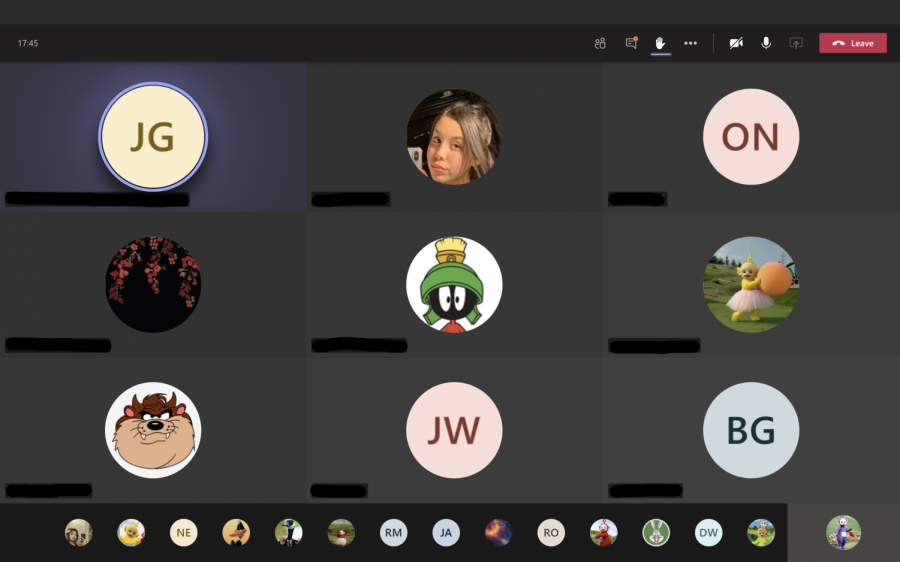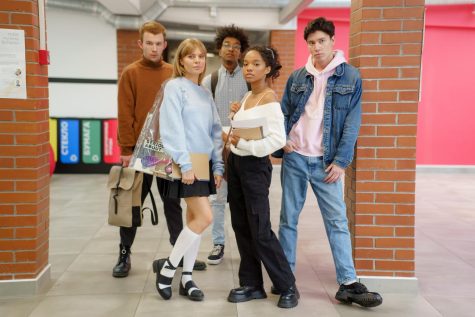Bursting the ‘Boundaries Bubble’
As remote learning becomes the norm in the age of COVID-19, students should not have to burst their “boundaries bubble” and be forced to turn on their cameras in class
Photo by Keidy
Junior Keidy Palma, copy editor for The Legend yearbook and AGO reporter, argues that students should not be forced to turn on their cameras during Teams classroom meetings.
A trembling hand approaches the mouse and slowly glides over the “turn on camera” function on the Teams app.
As dramatic as it sounds, this is the reality students across the nation face as teachers insist they turn their cameras on during remote learning.
Has transitioning to remote learning made it more difficult to connect with our classmates? Yes. Has it become more difficult for schools to create an engaging classroom? Yes. We understand your concerns. We live through them from 9 a.m. to 4 p.m. every weekday.
However, while we understand this transition has been hard, obligating students to turn on their cameras during class is not the solution for the distance between us. As remote learning becomes more of a normality due to the cases rising in our region, the constant pressure for students to turn their cameras on seems to be the norm too.
Forcing the invasion of a student’s privacy and making them feel uncomfortable in their own home should not be normalized.
There are many misconceptions about why students do not want to turn their cameras on. It is not because we are self-conscious. It is not because we want to argue with our teachers. And it is not because we are laying in bed — ok, maybe sometimes.
It is simply because it is an invasion of our privacy, increases the existing anxiety of remote learning and is extremely distracting. A study conducted by the Wall Street Journal reported that obligating students to turn on their cameras leads to heightened attention on the images they are gazing at, not the actual lectures being presented.
When face-to-face at school, students had the option of disclosing personal information with their teachers and peers. Now with remote learning, students are forced to allow others into their homes when obliged to turn on their cameras. To put this into perspective, a study conducted by the American Immigration Council showed that 6 million children live with a person(s) who is undocumented.
Forcing students to turn on their cameras puts a student and their families at risk of exposing information to authorities. Also, students who come from lower-income households, or have other difficult family situations, may be afraid or embarrassed to turn their cameras on, leaving them to feel “called out” or singled out when teachers start making “cameras-on” a requirement.
In high school, we are hormone-filled monsters that ooze anxiety and stress. After all, there is a reason behind the term “teenage angst” isn’t there? When students are obligated to turn on their cameras, they have to mold their home life and school life into one. This can come with many anxieties and stress-inducing scenarios.
In fact, it is scientifically proven by the American Institute of Stress that forcing a student to turn their cameras on triggers a “flight or fight” response in the brain as large faces on a screen begin tricking your brain into thinking a person is closer than they appear.
Faculty at school campuses argue that ensuring everyone has their cameras on will eliminate the distance between us and will keep students connected to their teachers and peers. Incorrect.
Although this idea seems nice, you are speaking about teenagers here. Online learning does not change the fact that teenagers love to compare themselves to others and constantly worry about their looks. The reality of it is, students spend more time looking at themselves and the backgrounds of others rather than paying attention in class. Enforcing cameras to be on can seem unifying, and in normal conditions, it is, but this is not the case with our current circumstances. In fact, this can make students feel even more lonely and dissociated.
According to Time USA, video chats make one yearn for real-life connections even more. Because the computer screens eventually have to close, students feel even more divided after a class with all cameras on.
Undeniably, this is a difficult situation. There is no perfect solution because things are constantly changing. However, there is always a better way to do something. Instead of obligating students to turn on their cameras in class, let’s begin by creating a safe space in our remote classrooms, ensuring students feel comfortable turning on their cameras before making them do so. Let’s not obligate students to burst their personal space bubble and instead create lessons that will help students become more comfortable with our situation — and each other — before enforcing cameras.
You’ll be surprised at the number of cameras that turn on after that. The world’s current situation is enough to trigger our “flight or fight” responses, let’s not make remote learning one of them too.






